
The Lute Player is an oil-on-canvas painting from 1623 or 1624 now in the Louvre by the Haarlem painter Frans Hals, showing a smiling actor wearing a jester's costume and playing a lute.

Yonker Ramp and His Sweetheart is an oil-on-canvas painting by the Dutch Golden Age painter Frans Hals, painted in 1623 and now in the Metropolitan Museum of Art, New York City. The painting has also been titled as Young Man and Woman in an Inn or Portrait of Pieter Ramp.

Two singing boys with a lute and a music book is a painting by the Dutch Golden Age painter Frans Hals, painted c. 1625 and now in the Museum Schloss Wilhelmshöhe.

Laughing Fisherboy is an oil-on-canvas painting by the Dutch Golden Age painter Frans Hals, painted in 1628 and now in Westphalia.

The Rommelpot Player is a painting by the Dutch Golden Age painter Frans Hals, painted in 1618–1620 and now in the Kimbell Art Museum. It is considered the best of several versions of a Rommelpot player by Frans Hals.

Portrait of a Man in a Yellowish-gray Jacket is an oil-on-panel portrait painting by the Dutch Golden Age painter Frans Hals, painted in 1633 and now in the Staatliche Kunstsammlungen Dresden, Dresden.

Boy with a Glass and a Lute is an oil-on-canvas painting by the Dutch Golden Age painter Frans Hals, painted in 1626 and now in the Guildhall Art Gallery, London.

Laughing boy with a flute is an oil-on-panel painting by the Dutch Golden Age painter Frans Hals, painted in 1626 and now in the Staatliches Museum Schwerin, Schwerin.
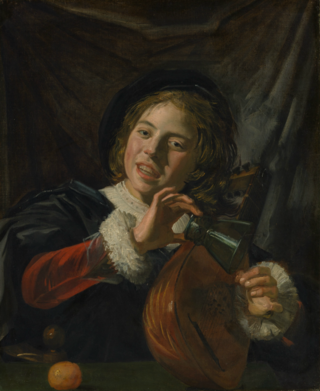
The Fingernail Test is an oil-on-canvas Dutch Golden Age painting that has been attributed to either Frans Hals or Judith Leyster, painted in 1626 and now in the Metropolitan Museum of Art, New York City.

Laughing Boy with a Flute is an oil-on-canvas painting by the Dutch Golden Age painter Frans Hals, painted in the early 1620s.
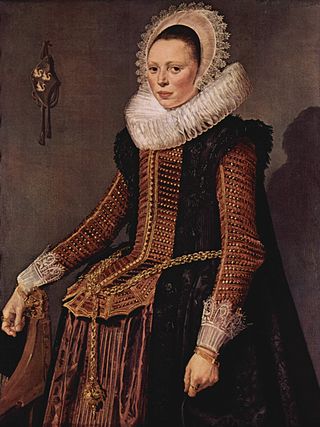
Portrait of a Woman Standing (Kassel) is a painting by the Dutch Golden Age painter Frans Hals, painted in 1618–1620 and now in Gemäldegalerie Alte Meister (Kassel). It is considered a pendant portrait to the Portrait of a Man Standing, in the same museum.

Catharina Both van der Eem is a painting by the Dutch Golden Age painter Frans Hals, painted in 1620 and now in Louvre Museum. It is considered a pendant portrait to the Portrait of Paulus van Beresteyn, in the same museum.
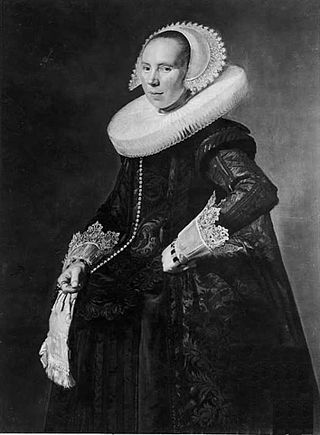
Portrait of Cunera van Baersdorp is an oil-on-panel painting by the Dutch Golden Age painter Frans Hals, painted in 1625 and now in a private collection. It is considered a pendant portrait to the Portrait of a Man Standing, now identified as Cunera's husband Michiel de Wael.

Smiling Fishergirl is an oil-on-canvas painting by the Dutch Golden Age painter Frans Hals, painted in the early 1630s, now in a private collection.

Portrait of Catharina Brugman is an oil-on-canvas painting by the Dutch Golden Age painter Frans Hals, painted in 1634 and now in a private collection. It is considered a pendant to the portrait of Catharina's husband Tieleman Roosterman.
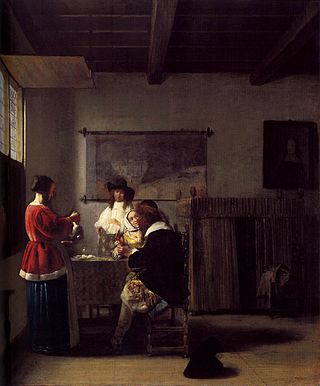
Merry Company with Two Men and Two Women, also known as The Visit, is an oil-on-panel painting by the Dutch painter Pieter de Hooch, created c. 1657. It is an example of a Merry Company, a popular form of genre painting in Dutch Golden Age painting showing a group of figures, who are not meant to be identified as portraits, enjoying each other's company. It is now in the Metropolitan Museum of Art, in New York.
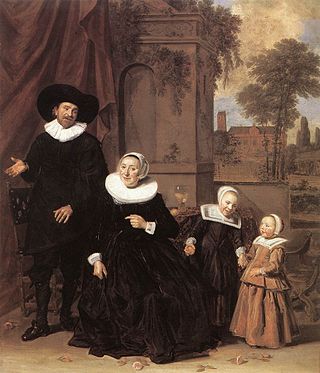
Portrait of a Dutch Family is an oil-on-canvas painting by the Dutch Golden Age painter Frans Hals, painted c. 1635 and now in the Cincinnati Art Museum, Cincinnati.

Family Group in a Landscape is an oil-on-canvas painting by the Dutch Golden Age painter Frans Hals, painted c. 1645-1648, and now in the Museo Thyssen-Bornemisza, in Madrid.

Portrait of Mrs. Bodolphe is an oil-on-canvas painting by the Dutch Golden Age painter Frans Hals, painted in 1643 as half of a pair of pendant marriage portraits and is still together with its pendant in the Yale University Art Gallery, New Haven, Connecticut.

Portrait of a Man is an oil-on-canvas painting by the Dutch Golden Age painter Frans Hals, painted c. 1660 and now in the Frick Collection, New York City. The man has been mistakenly identified as Michiel de Ruyter.


























